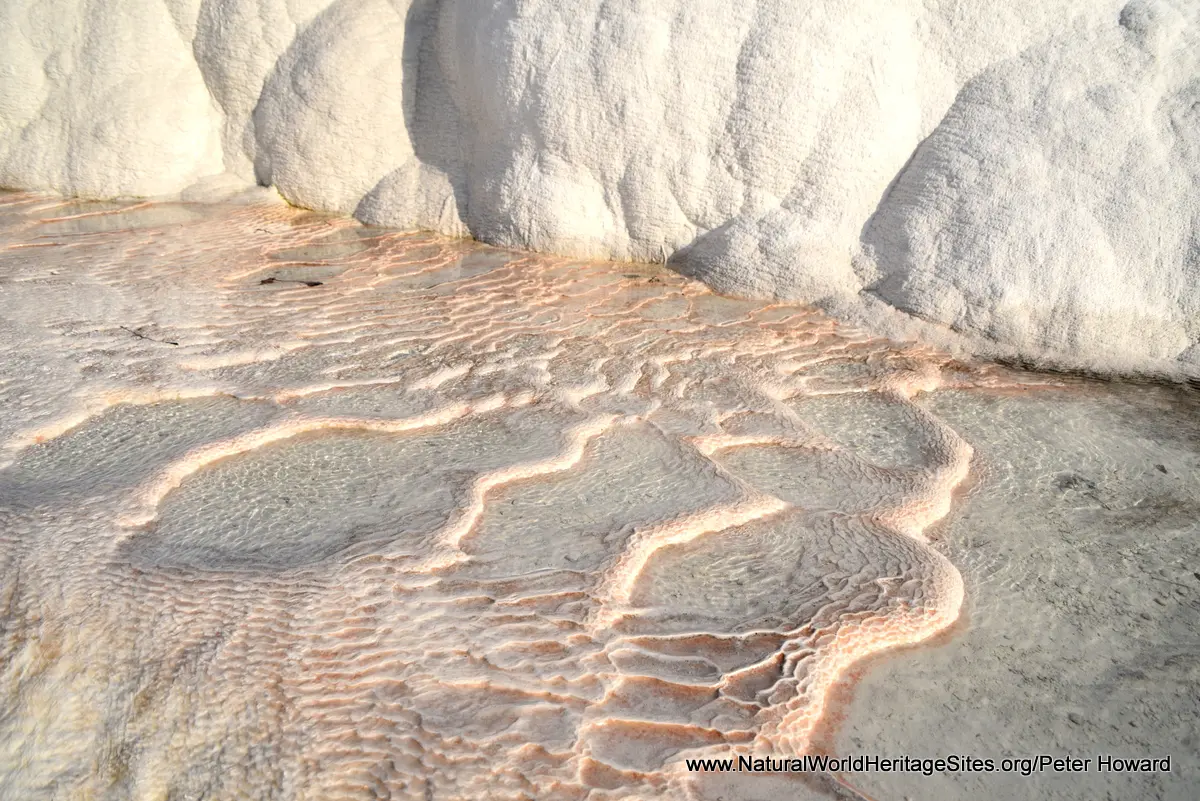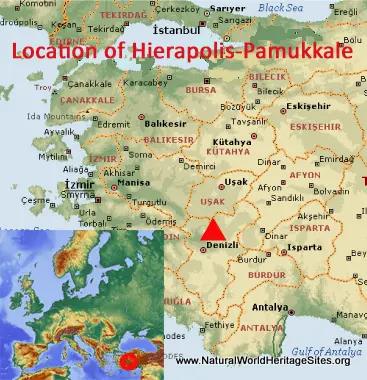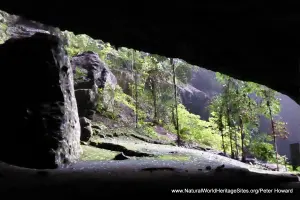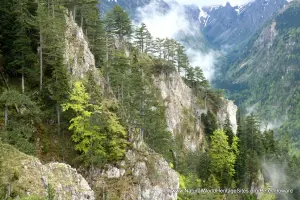EXPLORE HIERAPOLIS-PAMUKKALE with this slideshow, check the location map and get all the facts and information below.
For slideshow description see right or scroll down (mobile). Click to view slideshow
Location and Values: Hierapolis-Pamukkale is located in south-western Turkey, on the lower slopes of the western Taurus Mountains. Here a number of mineral-rich hot springs emerge from a geological fault at the top of a steep slope, giving rise to an extensive series of gleaming-white travertine terraces below. The healing properties of the mineral waters have long been recognized and the Graeco-Romano-Byzantine town of Hierapolis developed around the springs at the top of the hillside from as early as the second century B.C.
The travertine terraces cover an area 2,500m long by 500m wide over a hillside 200m high. They are formed by the deposition of calcium carbonate as the mineral-rich waters cascade down the hillside in a series of petrified cascades. The terraces typically retain a shallow pool of water which spills gently over a natural rim and creates a vertical wall of stalactites, like a petrified cascade, between each level. The semi-circular pools at each level often reflect the clear blue sky above, contrasting with the gleaming white crystalline formations of the terraces to create a scene of unparalleled natural beauty.
Conservation Status and Prospects. According to IUCN’s Conservation Outlook Assessment (2017) the conservation status of Hierapolis-Pamukkale is ‘good, with some concerns’. The IUCN report notes that ‘the natural values of Hierapolis-Pamukkale, as well as its cultural attributes, caused a flood of tourists to visit the site which in turn stimulated the rapid growth of tourist infrastructure. The diversion of spring water to feed hotel pools, pollution by sewage, mechanical damage to the stone and constant tourist bathing and littering in the pools diminished them and began to turn the travertine grey. Moreover, the thermal water flow that feeds the travertine terraces has decreased compared to previous times. The encroaching hotel development was therefore pushed back and the commercial use of water came under control. As a consequence the quality of the travertine deposit is returning. However, high tourist numbers are still an issue which requires careful management for which the current level of staffing is insufficient.’
Links:
Google Earth
UNESCO Official Website
IUCN Conservation Outlook
UNEP-WCMC Site Description
Slideshow description
The slideshow features a series of photos from a visit to Hierapolis-Pamukkale by Peter Howard over two days in mid-October 2018. It shows the main attributes of the natural travertine terraces and the archaeological site of Hierapolis built around the natural hot springs at the top of the cliffs. At the time of this visit there was very little water flowing over the natural terraces, as most of it was being channeled into a series of about 15 artificial pools along the course of an old road cutting through the eastern portion of the terraces. This old road was closed and now serves as a footpath through the site, enabling visitors to paddle and bathe in the artificial pools, and view the adjacent areas without venturing onto the natural terraces (where they may damage the natural formations). The shortage of water in the natural terraces at the time of this visit compromised the natural beauty of the place. It is not clear whether this was due to exceptional circumstances (such as drought) or the result of unsustainable use of water from the springs (to supply hotel spas, for example).
The photos in the first part of the slideshow give a sense of the inherent beauty of the gleaming white stalactite formations of the terraces and fresh calcite deposits along the old road. The turquoise blue waters and calcite-encrusted walls of the artificial pools give a semi-natural appearance and satisfy visitors’ demands to paddle and bathe. Photos of the channels used to manage water flows from the natural springs highlight the degree of management intervention made at the site and the lack of water in the natural travertine terraces means the visitor can only imagine what this place could be like if water was still flowing over the terraces, as in the past.
The second part of the slideshow covers the ruins at the Hierapolis archaeological site on the plain above Pamukkale. It shows the modern new visitor service centre at the busy northern entrance, and some overviews of the site, most of which has been severely impacted by earthquake activity over the centuries (and is now subject to meticulous reconstruction). There is a very extensive Roman-era necropolis outside the city limits, where elaborately carved sarcophagi lie open and exposed in the rolling grasslands. In the main section of the archaeological site a partially restored colonnaded main street can be seen, alongside extensive baths and other areas under renovation, and a magnificent theatre. Some of the best sarcophagi, statuary and carved friezes from the theatre are on display in a site museum, and an ‘antique pool’ at the source of one of the thermal springs is open for visitors to bathe amongst the ancient stone columns that toppled into the water long ago.
The final part of the slideshow returns to the travertine terraces with some close-up detail of the stalactites and calcite formations, and visitors enjoying the bathing opportunities in the artificial pools along the old road. The last few photos show a small section of natural travertine terraces with (8-10) water-filled pools, which benefited from a temporary supply of water channeled down the slope to re-fill the artificial bathing pools immediately below. These photos (with a long telephoto lens) give a sense of the inherent beauty of place and the crucial role of the mineral-rich water in maintaining it.
Factfile
Website Category: Caves & Karst
Area: 11 km2
Inscribed: 1988
Criteria (mixed site):
- Exceptional natural phenomenon (vii);
- Outstanding natural beauty (vii);
- Cultural criteria (iii,iv)





